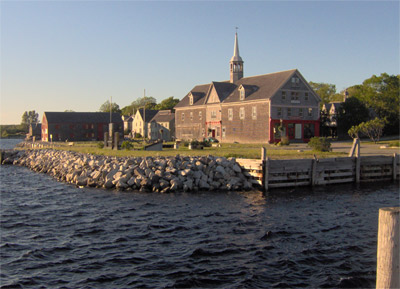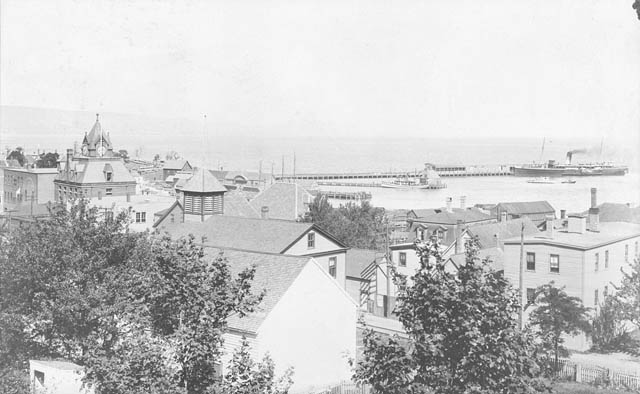|
Amos Pentz
Amos Parker Pentz (December 11, 1849 – December 11, 1922) was a Canadian shipbuilder from Shelburne, Nova Scotia. He was noted for his fast and innovative designs of fishing schooners and trawlers. He was born in Beach Meadow, Queens County, Nova Scotia, to Martin Pentz and Eliza Jane Maxwell. From a young age, Pentz had always taken a strong interest in ships. As he became older, his passion for ships turned into his livelihood. The combination of his talent for woodwork, and knowledge of ships, created a foundation for a lifetime of success in his field of work. He began his career in 1872 as an itinerant ship builder. He slowed his career down briefly around 1891 when he married Annie Matthews (on October 24, 1891). Pentz and his family eventually moved on to Shelburne to continue his work with shipbuilding. He was employed at the Joseph McGill Ship Yard, where he set a new example for what skills a master ship builder should have. Over is lifetime he produced an impressive ... [...More Info...] [...Related Items...] OR: [Wikipedia] [Google] [Baidu] |
Shelburne, Nova Scotia
Shelburne is a town located in southwestern Nova Scotia, Canada. History Shelburne lies at the southwest corner of Nova Scotia, at roughly the same latitude as Portland, Maine in the United States. The Mi'kmaq call the large and well-sheltered harbour ''Logumkeegan'' or ''Sogumkeagum.'' The first Europeans to make a settlement on these shores were the French Acadians. They set up a small fishing settlement known as Port Razoir in the late 17th century, named after the harbour's resemblance to an open razor. Early European settlers had small subsistence farms, but most of the inhabitants' income from that time to the present has been derived from the sea. The Acadian fishing settlement was abandoned after repeated raids from New England colonists during Queen Anne's War in 1705, in which five Acadians were taken prisoner, and again in 1708. Raid on Port Roseway (1715) On May 14, 1715, New England naval commander Cyprian Southack attempted to create a permanent fishing station a ... [...More Info...] [...Related Items...] OR: [Wikipedia] [Google] [Baidu] |
Queens County, Nova Scotia
Queens County is a county in the Provinces and territories of Canada, Canadian province of Nova Scotia. History Liverpool, Nova Scotia, Liverpool, the county seat of Queens County, was founded in 1759 by the New England Planters. Founded for the most part by New England settlers, Liverpool maintained strong ties with the American colonies until the sudden outbreak of the American Revolution. On July 21, 1762 the Lieutenant Governor and Council of Nova Scotia declared that "the Townships of Liverpool, Barrington and Yarmouth together with the intermediate lands should be erected into a county by the name of Queens County". Parts of the new county were taken from Lunenburg County, Nova Scotia, Lunenburg County, which now lies to the northeast. In 1784, Shelburne County, Nova Scotia, Shelburne County was formed in part from southwestern portions of Queens County. The new county boundaries were established by an Order-in-Council dated December 16, 1785. Queens County contains subs ... [...More Info...] [...Related Items...] OR: [Wikipedia] [Google] [Baidu] |
Frederick William Wallace
Frederick William Wallace (December 11, 1886 – July 15, 1958) was a journalist, photographer, historian and novelist. He is best known as the author of ''Wooden Ships and Iron Men'', a now-classic 1924 book about the last days of the Age of Sail in Maritime Canada. Life and career Born in Glasgow, Scotland, he initially worked as a clerk but turned to the sea as a journalist of the fishing industry which later led to historical work. Wallace served in World War I as commander of a Q-Ship. After the war, he edited the monthly journal ''Canadian Fisherman'' which would be his main occupation for forty years. This publication, which ran from 1917 to 1970, remains an important source of information for researchers today. He would also write short stories for such pulp magazines as ''Adventure'' between 1912 and 1922 Wallace began publishing novels in 1907, beginning with ''Blue Water'' and several other works including ‘’Salt Seas and Sailormen’’ (Copyright, Canada 19 ... [...More Info...] [...Related Items...] OR: [Wikipedia] [Google] [Baidu] |
Digby, Nova Scotia
Digby is an incorporated town in southwestern Nova Scotia, Canada. It is in the historical Digby County, Nova Scotia, county of Digby and a separate municipality from the Municipality of the District of Digby. The town is situated on the western shore of the Annapolis Basin near the entrance to the Digby Gut, which connects the basin to the Bay of Fundy. Named after Robert Digby (Royal Navy officer), Admiral Robert Digby, the town has a scallop fishing fleet. The MV Fundy Rose, MV ''Fundy Rose'' ferry service connects the town to Saint John, New Brunswick. History Digby is called Oositookun, meaning ear of land, by the Mi'kmaq. A small group of New England Planters settled in the area of the town in the 1760s naming it Conway. However Digby was formally settled and surveyed as a town in June 1783 by the United Empire Loyalists under the leadership of Sir Robert Digby (admiral), Robert Digby. The town developed a sizable shipping fleet in the 19th century. One famous Digby vessel ... [...More Info...] [...Related Items...] OR: [Wikipedia] [Google] [Baidu] |
James Havelock Harding
James Havelock Harding, was a master shipwright and shipbuilder who worked at Shelburne, Nova Scotia. He was born in Queens County, Nova Scotia, Canada in 1883. origins Four Harding Brothers arrived in Shelburne as United Empire Loyalist. Three of the brothers had kids. One of these, Jasper Hard, was James Harding's great grandfather. Jasper Harding was born in 1748 in Ireland. He married Elizabeth Hanson from Delaware in 1786. They had several children. Their third son Richard married Isabella MacDonald in 1822. They had a son Cornelius who married Mary Ann Decker. Early life Harding was born in Northfield, Queens County, Nova Scotia. His father, Cornelius Harding married Mary Ann Decker. Together they had four children; Hedley Vickers (1865), Isabel (1876), Elizabeth Ann (1880) and James Havelock (1883) Harding. At a young age he moved to Shelburne and in 1900, he joined the workforce at McGill Shipyard. This career choice led to him becoming one of the most respected master sh ... [...More Info...] [...Related Items...] OR: [Wikipedia] [Google] [Baidu] |
Canadian Shipbuilders
Canadians (french: Canadiens) are people identified with the country of Canada. This connection may be residential, legal, historical or cultural. For most Canadians, many (or all) of these connections exist and are collectively the source of their being ''Canadian''. Canada is a multilingual and multicultural society home to people of groups of many different ethnic, religious, and national origins, with the majority of the population made up of Old World immigrants and their descendants. Following the initial period of French and then the much larger British colonization, different waves (or peaks) of immigration and settlement of non-indigenous peoples took place over the course of nearly two centuries and continue today. Elements of Indigenous, French, British, and more recent immigrant customs, languages, and religions have combined to form the culture of Canada, and thus a Canadian identity. Canada has also been strongly influenced by its linguistic, geographic, and ec ... [...More Info...] [...Related Items...] OR: [Wikipedia] [Google] [Baidu] |
People From Queens County, Nova Scotia
A person ( : people) is a being that has certain capacities or attributes such as reason, morality, consciousness or self-consciousness, and being a part of a culturally established form of social relations such as kinship, ownership of property, or legal responsibility. The defining features of personhood and, consequently, what makes a person count as a person, differ widely among cultures and contexts. In addition to the question of personhood, of what makes a being count as a person to begin with, there are further questions about personal identity and self: both about what makes any particular person that particular person instead of another, and about what makes a person at one time the same person as they were or will be at another time despite any intervening changes. The plural form "people" is often used to refer to an entire nation or ethnic group (as in "a people"), and this was the original meaning of the word; it subsequently acquired its use as a plural form of per ... [...More Info...] [...Related Items...] OR: [Wikipedia] [Google] [Baidu] |
Transport In Shelburne County, Nova Scotia
Transport (in British English), or transportation (in American English), is the intentional movement of humans, animals, and goods from one location to another. Modes of transport include air, land ( rail and road), water, cable, pipeline, and space. The field can be divided into infrastructure, vehicles, and operations. Transport enables human trade, which is essential for the development of civilizations. Transport infrastructure consists of both fixed installations, including roads, railways, airways, waterways, canals, and pipelines, and terminals such as airports, railway stations, bus stations, warehouses, trucking terminals, refueling depots (including fueling docks and fuel stations), and seaports. Terminals may be used both for interchange of passengers and cargo and for maintenance. Means of transport are any of the different kinds of transport facilities used to carry people or cargo. They may include vehicles, riding animals, and pack an ... [...More Info...] [...Related Items...] OR: [Wikipedia] [Google] [Baidu] |
1849 Births
Events January–March * January 1 – France begins issue of the Ceres series, the nation's first postage stamps. * January 5 – Hungarian Revolution of 1848: The Austrian army, led by Alfred I, Prince of Windisch-Grätz, enters in the Hungarian capitals, Buda and Pest. The Hungarian government and parliament flee to Debrecen. * January 8 – Hungarian Revolution of 1848: Romanian armed groups massacre 600 unarmed Hungarian civilians, at Nagyenyed.Hungarian HistoryJanuary 8, 1849 And the Genocide of the Hungarians of Nagyenyed/ref> * January 13 ** Second Anglo-Sikh War – Battle of Tooele: British forces retreat from the Sikhs. ** The Colony of Vancouver Island is established. * January 21 ** General elections are held in the Papal States. ** Hungarian Revolution of 1848: Battle of Nagyszeben – The Hungarian army in Transylvania, led by Josef Bem, is defeated by the Austrians, led by Anton Puchner. * January 23 – Elizabeth Blackwell is awarded her M.D. by the Medi ... [...More Info...] [...Related Items...] OR: [Wikipedia] [Google] [Baidu] |


_1938.jpg)
